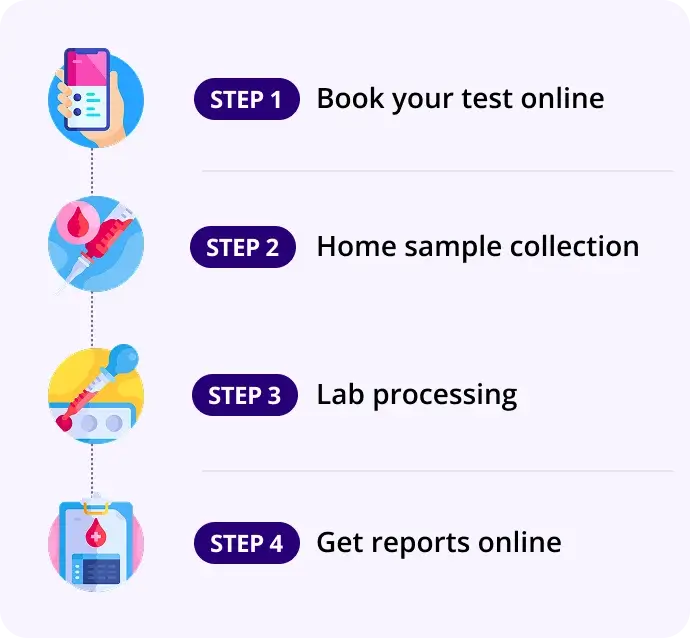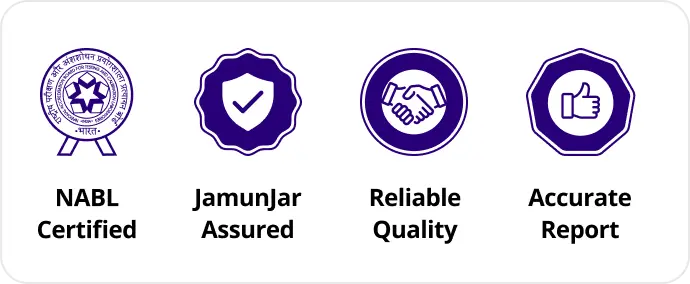Iron Studies (Iron, TIBC, Transferrin Saturation)
Report in 16Hrs
At Home
Fasting Required
Details
Evaluate causes of fatigue, pallor, hair loss, or restless leg syndrome
₹249₹660
62% OFF
🧪 What Are Iron Studies?
Iron studies assess how much iron is in the blood and how well it is transported and stored. The key components are:
- Serum Iron – Measures circulating iron bound to transferrin
- TIBC (Total Iron Binding Capacity) – Reflects the blood’s capacity to bind iron with transferrin
- Transferrin Saturation (%) – Calculated by:
Transferrin Saturation=(Serum IronTIBC)×100\text{Transferrin Saturation} = \left( \frac{\text{Serum Iron}}{\text{TIBC}} \right) \times 100Transferrin Saturation=(TIBCSerum Iron)×100
Shows the % of transferrin that is actually bound with iron
❓ Why Are They Done?
To:
- Diagnose iron deficiency anemia or chronic anemia
- Detect iron overload (e.g., hemochromatosis, thalassemia)
- Evaluate causes of fatigue, pallor, hair loss, or restless leg syndrome
- Monitor iron therapy
- Assess iron metabolism in chronic kidney or liver disease
📊 Normal Ranges
Parameter | Normal Range |
|---|---|
Serum Iron | 60 – 170 µg/dL |
TIBC | 240 – 450 µg/dL |
Transferrin Saturation | 20 – 50% |
Ranges may vary slightly between labs. Women and children may have slightly lower levels.
📈 Interpretation of Results
Pattern | Iron | TIBC | Transferrin Sat | Interpretation |
|---|---|---|---|---|
Iron Deficiency Anemia | ↓ | ↑ | ↓ | Poor iron availability |
Anemia of Chronic Disease | ↓ | ↓ or normal | ↓ | Inflammation reduces iron absorption |
Hemochromatosis (Iron Overload) | ↑ | ↓ or normal | ↑ > 60% | Too much iron absorption |
Pregnancy / Oral Contraceptives Use | ↓ | ↑ | ↓ | Due to increased TIBC |
Malnutrition / Liver Disease | ↓ | ↓ | ↓ or normal | Low production of transferrin |
🧠 Associated Organs & Conditions
System | Conditions |
|---|---|
Hematologic | Iron deficiency anemia, hemolytic anemia, thalassemia |
Liver | Hemochromatosis, hepatitis, cirrhosis |
Kidney | Anemia in chronic kidney disease |
Gastrointestinal | Bleeding ulcers, celiac disease, malabsorption |
Reproductive | Heavy menstruation, pregnancy-related anemia |
🔄 Follow-Up / Related Tests
- Ferritin – Reflects iron stores (↓ in deficiency, ↑ in overload/inflammation)
- Hemoglobin (Hb), Hematocrit
- Reticulocyte count
- Vitamin B12 & Folate
- Peripheral smear
- Stool occult blood – For GI blood loss
✅ Fasting Required?
Test | Fasting Required |
|---|---|
Iron Studies | ✅ Yes – 8–12 hours fasting (for most accurate serum iron and TIBC) |
📝 Summary Table
Parameter | Details |
|---|---|
What | Measures circulating iron, binding capacity, and saturation |
Why | Diagnose anemia, iron overload, or malabsorption |
Serum Iron Normal | 60–170 µg/dL |
TIBC Normal | 240–450 µg/dL |
Transferrin Saturation Normal | 20–50% |
High TSAT | Iron overload (e.g., hemochromatosis) |
Low TSAT | Iron deficiency, inflammation, malnutrition |
Follow-up Tests | Ferritin, Hb, RBC indices, stool occult blood |
Associated Conditions | Anemia, chronic inflammation, liver disease |
Fasting Required | ✅ Yes |
How our test process works!

